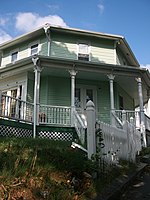Clark University is a private research university in Worcester, Massachusetts. Founded in 1887 with a large endowment from its namesake Jonas Gilman Clark, a prominent businessman, Clark was one of the first modern research universities in the United States. Originally an all-graduate institution, Clark's first undergraduates entered in 1902 and women were first enrolled in 1942.The university now offers 46 majors, minors, and concentrations in the humanities, social sciences, natural sciences, and engineering and allows students to design specialized majors and engage in pre-professional programs. It is noted for its programs in the fields of psychology, geography, physics, biology, and entrepreneurship and is a member of the Higher Education Consortium of Central Massachusetts which enables students to cross-register to attend courses at other area institutions including Worcester Polytechnic Institute and the College of the Holy Cross. As a liberal arts–based research university, Clark makes substantial research opportunities available to its students, notably at the undergraduate level through LEEP project funding, yet is also respected for its intimate environment as the second smallest university counted among the top 66 national universities by U.S. News & World Report and as one of 40 Colleges That Change Lives. It is classified among "R2: Doctoral Universities – High research activity". It was a founding member of the Association of American Universities, but departed in 1999.
Graduate and professional programs are offered through the Graduate School, the Graduate School of Management, the Graduate School of Geography, the Frances L. Hiatt School of Psychology, the Gustaf H. Carlson School of Chemistry, the Adam Institute for Urban Teaching and School Practice, the International Development, Community and Environment (IDCE), and the School of Professional Studies, and the Strassler Center for Holocaust and Genocide Studies.The university competes intercollegiately in 17 NCAA Division III varsity sports as the Clark Cougars and is a part of the New England Women's and Men's Athletic Conference. Intramural and club sports are also offered in a wide range of activities.Clark faculty and alumni have founded numerous companies and organizations, including Panera Bread, the American Psychological Association, and the American Physical Society, and have played leading roles in the development of modern rocketry, the wind chill factor, and the birth control pill. The university is also the alma mater of at least three living billionaires, in addition to its alumni having won three Pulitzer Prizes, multiple Suey Awards, and an Emmy Award.












